在冷戰對抗的國際政治結構中,台灣成為美國圍堵共黨擴張的前線。1951-65年間,美國對台提供大量的軍事、經濟、技術和教育文化援助,主導戰後台灣現代化的發展。美援中所呈現出的現代性,遂成為台灣追求現代國族文化認同的來源。為了要理論化「美援現代性」為一種實踐方法,並體現「中國」的文化立場,早期現代主義者訴諸中國傳統文化和哲學,來解釋現代主義的思想。然而,由於美援中所呈現出的現代性是高度選擇性和政治性,因此,把美援等同於西方現代性,再以中國傳統哲學來加以詮釋與應用,其合宜性與正當性是有爭議的。然而,持續了十五年的美援,讓「美援現代性」成為建設強大現代國家的主要範式,進而形成台灣在1950-60年代間,一種結合美國現代主義與中國文化傳統,來追求「現代中國」身份認同的獨特進路。......(全文請見《實構築季刊》03期)
In the international political structure of the Cold War confrontation, Taiwan had become the front line for the United States to contain the expansion of the Communism. From 1951 to 1965, the United States provided a large amount of military, economic, technical, educational and cultural supports to Taiwan, and led the development of Taiwan's modernization after World War Two. The modernity presented in the US aid had become a source of Taiwan's pursuit of modern national and cultural identity. In order to theorize "American aid modernity" as a practical method and reveal Chinese cultural position, early architectural modernists in Taiwan resorted to Chinese traditional culture and philosophy to explain the idea and theory of architectural modernism. However, because the modernity presented in the US aid is highly selective and political, it is highly problematic and controversial to equal it with Western modernity and then interpreted and applied by Chinese traditional philosophy. Nevertheless, the US aid that lasted for 15 years made the "American aid modernity" become the main paradigm for building a powerful modern country. As the result, it formed a unique approach that combined American modernism and Chinese cultural traditions to pursue "modern Chinese identity" in the 1950s and the 1960s in Taiwan.
